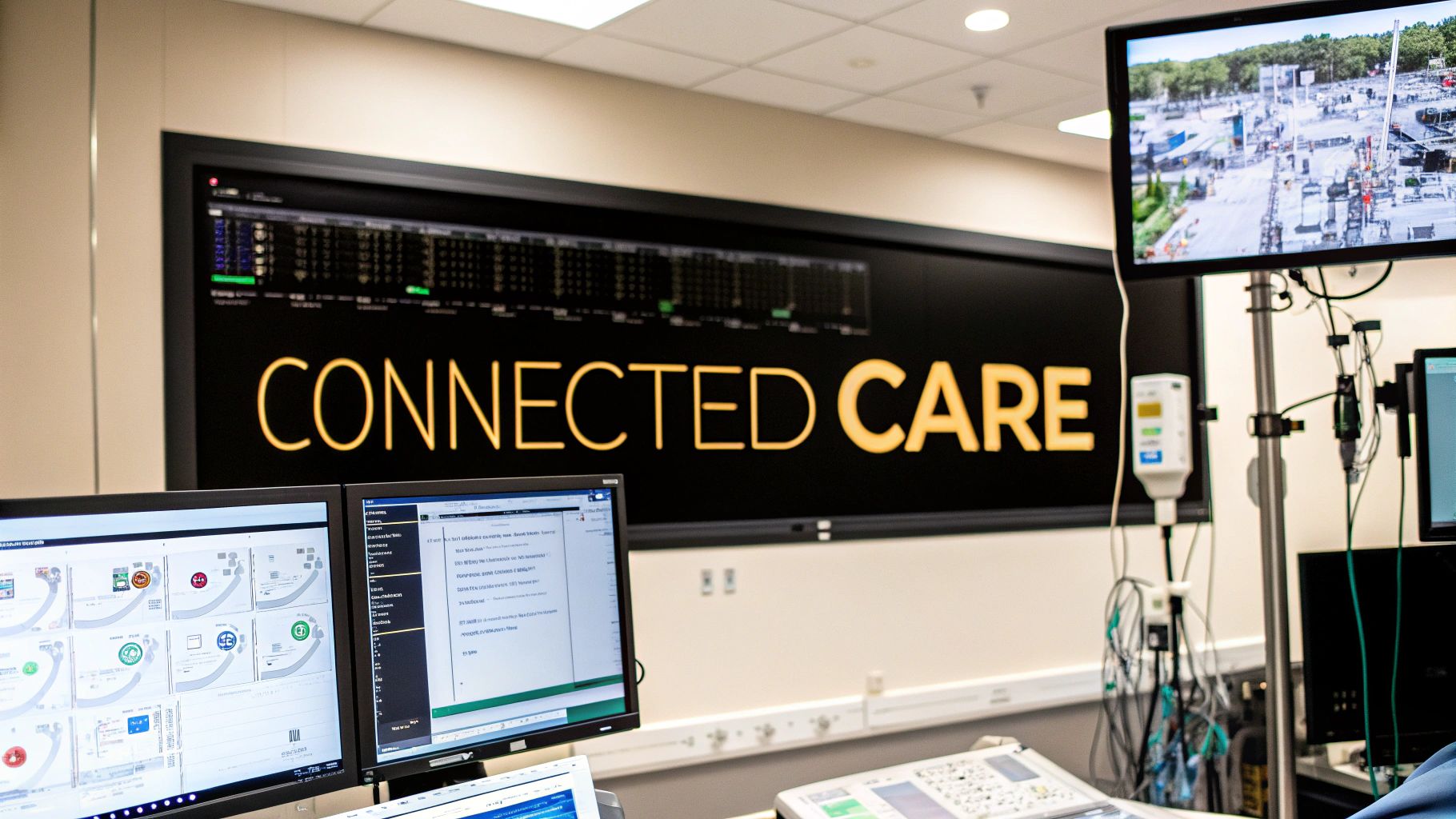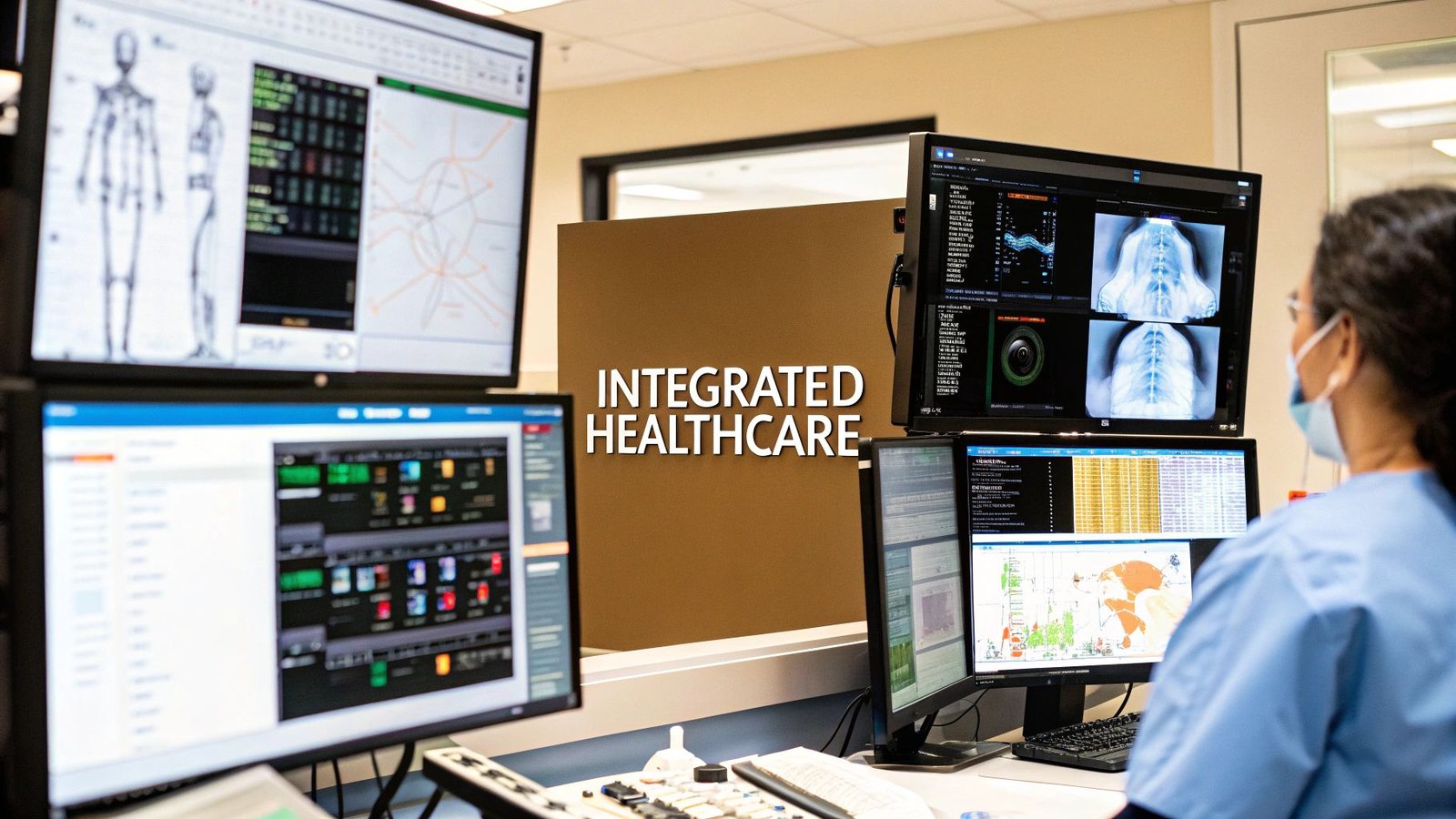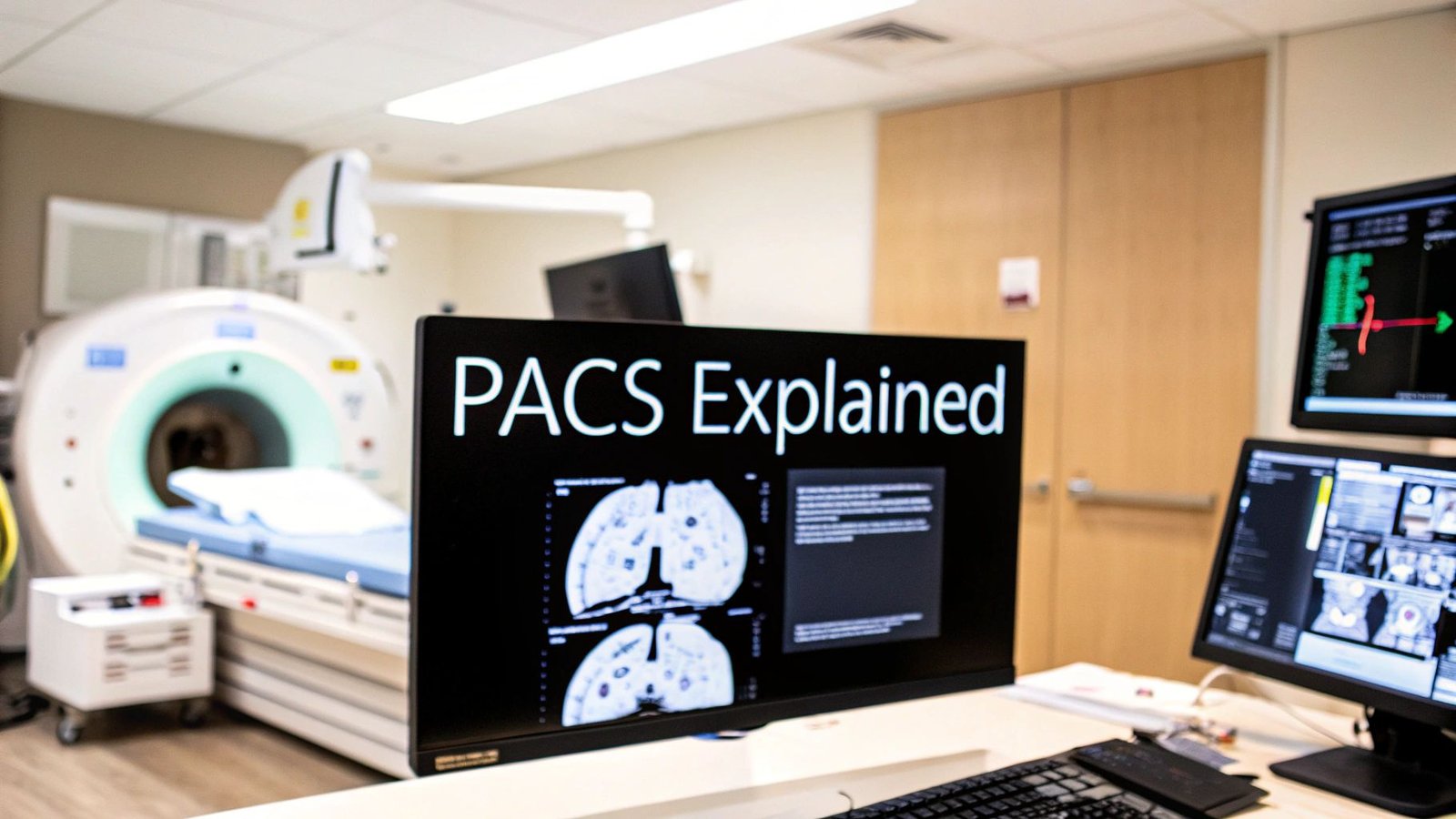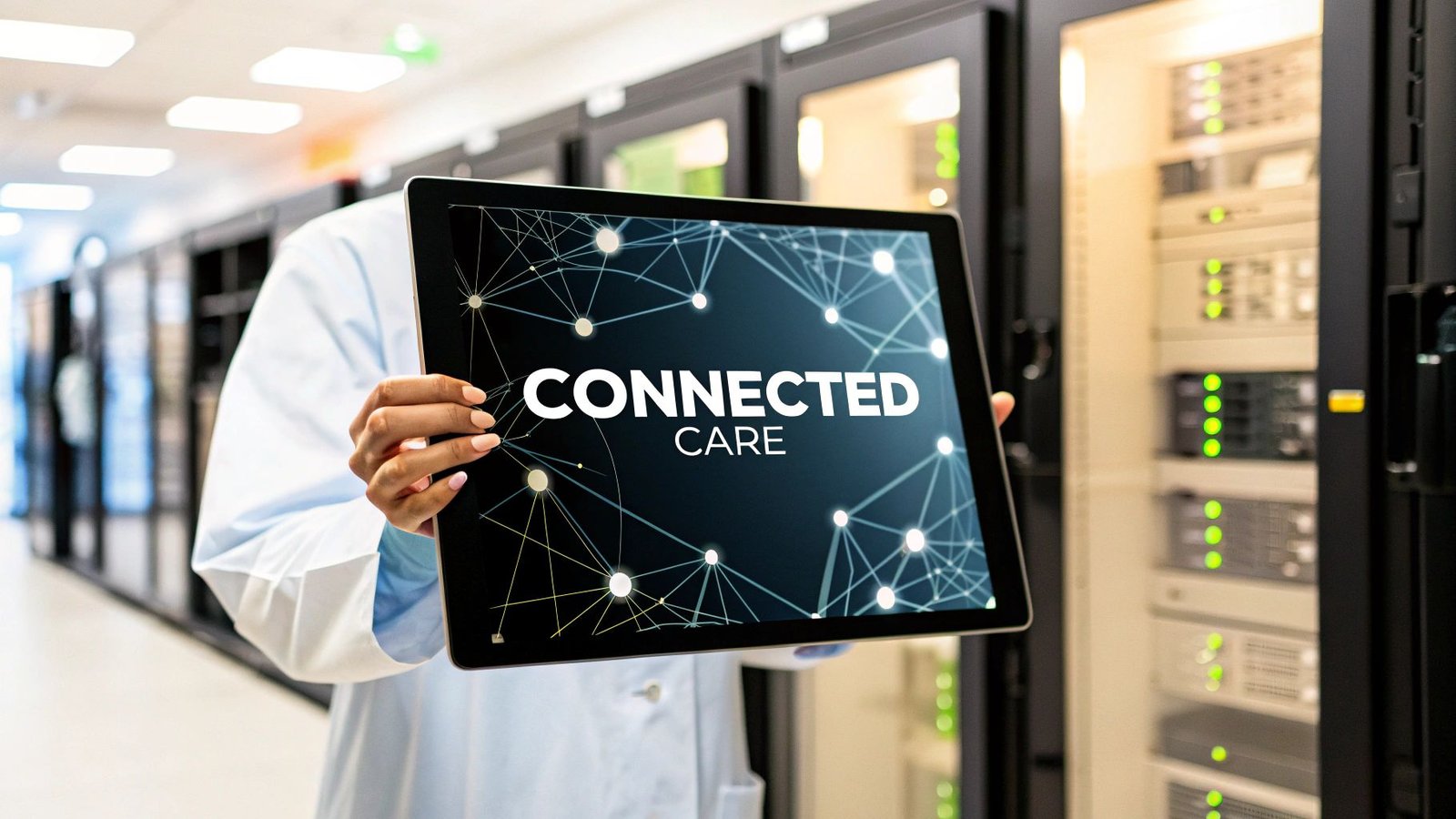Medical device connectivity is all about the technology and methods that let medical devices securely talk to each other and to larger health information systems. It’s the behind-the-scenes magic that replaces tedious manual data entry, which is a big win for reducing errors and giving clinicians back precious time. Think of it as creating a unified network where infusion pumps and vital sign monitors can send data directly to a patient's chart without anyone lifting a finger.
What Is Medical Device Connectivity

Picture a hospital floor where every single vital sign monitor, IV pump, and ventilator is constantly and automatically feeding information into a patient’s electronic health record (EHR). That's the real-world impact of medical device connectivity. It's essentially the universal translator for healthcare tech, allowing thousands of different devices from various manufacturers to speak the same language.
This technology represents a massive leap forward from the old days of isolated, standalone equipment. We're moving toward a truly integrated clinical environment. The main goal here is to automate the entire flow of patient data, getting rid of the slow, error-prone routine of writing things down by hand. It's a bigger problem than you might think—some research shows that an incredible 99% of medical device data never makes it into the EHR, which means crucial clinical insights are often lost forever.
From Manual Data to Automated Workflows
It wasn't long ago that the standard process involved a nurse walking from bedside to bedside, scribbling down readings on a clipboard, and then later transcribing that information into a patient’s chart. This workflow is a huge time-sink, but more importantly, it's a hotbed for transcription mistakes that can seriously affect patient safety.
Medical device connectivity solutions turn that entire process on its head. Data now flows automatically and securely from a device at the bedside straight into the EHR. This simple change ensures the information is:
- Timely: Clinicians get the data in near real-time, allowing for immediate review and action.
- Accurate: Automation cuts out the risk of human error during data entry.
- Comprehensive: Instead of occasional snapshots, you get a continuous stream of high-fidelity data, painting a much clearer picture of a patient's condition.
The Backbone of Modern Patient Care
This automated data capture isn't just about efficiency; it's a fundamental upgrade to the quality of care. When clinicians have a complete and precise view of a patient's health, they can make smarter decisions, faster. A respiratory therapist, for example, could instantly see how a change in ventilator settings is affecting a patient's cardiac output, all from one integrated view.
This seamless flow of information creates a cohesive story of the patient's journey, making sure nothing gets lost in translation as they move between departments. It turns what was once a collection of scattered data points into a powerful narrative for clinical decision-making.
In the end, these systems are the essential plumbing for modern, data-driven healthcare. They give caregivers the freedom to focus on their patients instead of being bogged down by technology. The result is a clinical environment that's safer, more efficient, and better positioned to deliver the best possible patient outcomes.
The Architecture of a Connected Clinical Ecosystem

To make medical device connectivity a reality, you need a carefully designed architecture where hardware and software work in lockstep. Think of it like a city's infrastructure: you have the physical roads (hardware) and a sophisticated traffic control system (software) ensuring everything gets from point A to point B efficiently and without a hitch. This structure is what turns raw data from the bedside into insights clinicians can actually use.
The foundation of it all is the physical hardware layer. This includes the medical devices themselves—infusion pumps, ventilators, patient monitors—but just as importantly, the networking gear that pulls and transmits their data. We're not talking about standard office networks here; these are specialized, medical-grade networks built for absolute reliability. Secure gateways are another key piece of the puzzle, acting as protected on-ramps that funnel data from many different devices into the hospital's central information system.
The demand for this kind of robust infrastructure is exploding. The global medical device connectivity market was recently valued at around USD 3.99 billion and is on track to hit USD 4.81 billion next year. That's a compound annual growth rate of roughly 20.09%. This boom is largely fueled by better wireless tech and cloud computing, which make real-time data flow more achievable than ever before. You can read more about the growth drivers of the medical device connectivity market.
The Software Layer: The Central Nervous System
If hardware is the skeleton of the connected ecosystem, then software is its brain and central nervous system. The most critical piece of this is the middleware platform. This specialized software acts as a universal translator, sitting between the massive variety of medical devices and the hospital's core systems, like its Electronic Health Record (EHR).
A typical hospital might have thousands of devices from hundreds of manufacturers, and almost none of them speak the same data "language." Middleware solves this by performing a crucial function called data normalization. It takes in all those different data streams and translates them into a single, standardized format the EHR can understand.
Middleware is the unsung hero of interoperability. It ensures that data from a 10-year-old IV pump and a brand-new patient monitor are both delivered to the EHR in a consistent, usable format, creating a single source of truth for patient care.
Without this translation layer, any attempt at true, facility-wide connectivity would grind to a halt. It’s the software that bridges the communication gap and keeps vital information from being trapped in device-specific silos.
Visualizing the Data Flow from Device to EHR
To see how all these parts work together, let's follow a single piece of data—a patient's heart rate—on its journey from the monitor to the medical record. This path shows the quiet elegance of a well-designed connectivity solution.
- Data Capture at the Bedside: A cardiac monitor is constantly tracking the patient’s heart rate, creating a nonstop stream of digital information.
- Secure Transmission: The monitor sends this data, usually over a secure Wi-Fi connection or a wired port, to a nearby connectivity gateway. This gateway first confirms the device is a trusted source.
- Ingestion by Middleware: From the gateway, the data packet is forwarded to the central middleware server. The middleware instantly recognizes the device type and the structure of its data.
- Normalization and Translation: The platform then translates the heart rate data from the monitor's proprietary language into a standard format, like HL7 or FHIR, that the hospital's EHR is built to receive.
- Secure Delivery to the EHR: Finally, the clean, standardized data is sent securely to the EHR, where it automatically populates the correct field in the right patient’s chart.
This whole trip happens in near real-time, often taking just a few seconds. It ensures the clinical team always has the most current, accurate information for making critical decisions, all without anyone having to type a single number. This automated workflow is the entire point of medical device connectivity solutions—turning a complex technical process into a seamless clinical advantage.
Decoding Healthcare's Data Languages
For any medical device connectivity to work, every piece of equipment—from a bedside monitor to a radiology workstation—has to speak the same language. Without these shared rules, critical patient data gets trapped in digital silos, unable to inform care decisions. Think of it like a United Nations assembly where every delegate speaks a different language, but there are no translators. It would be chaos.
In healthcare, these "languages" are data standards. They are the agreed-upon formats and protocols that allow different systems to exchange information in a way that makes sense. Getting a handle on these standards is the first step to understanding how a truly connected clinical environment gets built. Three major standards form the bedrock of modern healthcare interoperability: DICOM, HL7, and the newer, more adaptable FHIR. Each plays a unique and vital role.
DICOM: The Universal Language of Medical Images
Let’s say a radiologist performs a CT scan in Boston and needs a top specialist in Los Angeles to review it immediately. How do they ensure the specialist’s viewing software can open and read that image file perfectly, even if it’s from a completely different manufacturer? The answer is DICOM (Digital Imaging and Communications in Medicine).
DICOM is the undisputed global standard for everything involving medical imaging. It's much more than just an image format like a JPEG or PNG. It's a comprehensive protocol that dictates how medical images and all their related data are stored, printed, and transmitted.
- Standardized Structure: DICOM files intelligently bundle the image itself with a rich set of metadata. This includes everything from patient demographics and equipment settings to details about the study.
- Guaranteed Interoperability: This structure ensures that an MRI, X-ray, or ultrasound from any vendor's machine can be viewed and analyzed on any DICOM-compliant workstation or archiving system.
Frankly, without DICOM, hospitals would be stuck using equipment from a single company, unable to share vital diagnostic images with other providers. It is the foundation of modern radiology and cardiology.
This image shows how clinicians rely on integrated data from various sources to deliver better care.
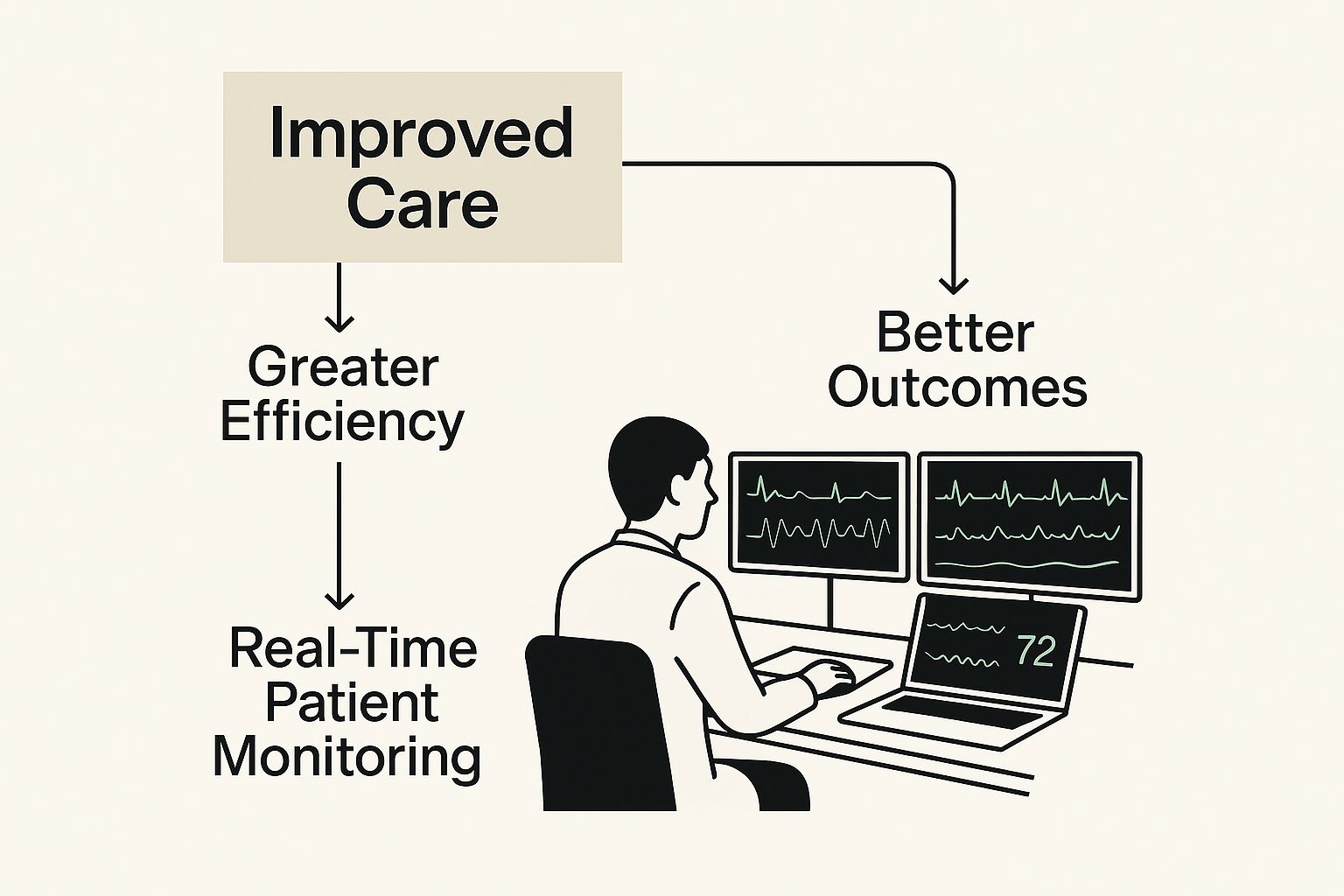
As you can see, the ultimate goal is to pull data from all these different devices and standards into one clear, actionable picture for the caregiver.
HL7: The Workhorse for Clinical and Administrative Data
While DICOM handles the pictures, HL7 (Health Level Seven) manages the words and numbers. For decades, HL7 has been the go-to standard for moving text-based clinical and administrative data between different healthcare apps. It’s the engine running in the background when a patient is admitted, lab results are sent to the EHR, or billing information gets processed.
Think of HL7 as the internal postal service for hospital data. It uses a structured, pipe-delimited message format. To the human eye, it looks a bit cryptic, but to a receiving system, it's perfectly clear. This ensures that when a lab system sends a blood glucose value, the EHR knows exactly what that number is and where to file it in the patient's chart.
HL7 messages are the lifeblood of hospital information systems, carrying millions of transactions daily for everything from patient admissions and discharge notifications to pharmacy orders and clinical observations.
Its long history is proof of its reliability, but its older structure can be pretty rigid. That rigidity makes it a poor fit for modern, web-based applications, which ultimately opened the door for a more agile successor.
FHIR: The Modern Standard for a Connected Age
The newest player on the block is FHIR (Fast Healthcare Interoperability Resources). Pronounced "fire," FHIR was designed from the ground up for a world of smartphones, cloud computing, and APIs. It uses the same web technologies that power sites like Google and Facebook, which makes it far easier for developers to work with.
If HL7 is the old-school postal service, FHIR is like a modern package tracking API. It breaks down massive medical records into small, logical chunks called "Resources"—things like a patient, a medication, or an observation. This granular approach allows developers to request only the specific sliver of data they need, instead of having to process a whole bulky message. This efficiency is absolutely critical for the medical device connectivity solutions that power mobile health apps and remote patient monitoring platforms today.
Comparison of Healthcare Interoperability Standards
To help put it all together, this table breaks down the distinct roles these three essential standards play in connecting healthcare data.
| Standard | Primary Use Case | Data Format | Key Strength |
|---|---|---|---|
| DICOM | Medical imaging (X-ray, MRI, CT scans) | Binary format with embedded metadata | Universal standard for all imaging modalities |
| HL7 v2 | Text-based clinical and administrative data | Pipe-delimited text messages | Widespread adoption in legacy hospital systems |
| FHIR | Web and mobile applications, modern data exchange | JSON, XML (RESTful API-based) | Flexibility, ease of use, and developer-friendly |
Together, these three data languages—DICOM for images, HL7 for traditional records, and FHIR for modern apps—form a powerful trio. They provide the rules of engagement that allow thousands of different medical devices and software systems to communicate, share data, and ultimately, work together to improve patient care.
Implementing Ironclad Security and Compliance
When you're dealing with connected medical devices, security isn't just another box to check—it's the very foundation of patient trust and safety. As streams of sensitive data flow from a bedside monitor to an electronic health record (EHR), they create new digital pathways, and with them, new opportunities for cyber threats. A security-first mindset isn't optional; it's the only way to build a connectivity solution that truly works.
The stakes couldn't be higher. Every single data point transmitted from a medical device is considered electronic Protected Health Information (ePHI). This simple fact puts it squarely under the strict regulatory eye of the Health Insurance Portability and Accountability Act (HIPAA). A failure here isn't just a technical glitch. It can lead to crippling fines, a shattered reputation, and, worst of all, a catastrophic breach of patient privacy.
That’s why any worthwhile connectivity solution has to be built from the ground up on a multi-layered security strategy. Adhering to strict Cybersecurity Compliance Essentials is completely non-negotiable. It's about weaving patient data protection and regulatory adherence into the plan from day one.
Core Pillars of a Secure Connectivity Framework
To create a genuinely secure environment, you have to focus on a few non-negotiable security measures. These aren’t fancy add-ons; they are the fundamental components of any responsible implementation. Think of them as the digital locks, alarms, and reinforced walls that guard your most sensitive information.
A solid approach always includes:
- End-to-End Encryption: All data has to be encrypted, both while it's moving across the network (in transit) and when it's sitting on a server or in the EHR (at rest). This essentially scrambles the information, making it unreadable to anyone who doesn't have the right key.
- Robust Device Authentication: You can't just let any device join the network. Secure protocols are needed to verify that only authorized, properly configured medical devices can connect and send data.
- Strict Access Controls: This is all about the principle of least privilege. Clinicians and IT staff should only have access to the specific data and systems they absolutely need to do their jobs. It’s a simple but powerful way to prevent unauthorized internal access.
Protecting patient data is a continuous process, not a one-time setup. It involves constant vigilance, regular security audits, and a proactive stance on identifying and patching vulnerabilities before they can be exploited.
Navigating Common Vulnerabilities
Even with a strong foundation, several common vulnerabilities can easily undermine a hospital's defenses. These weak points are the prime targets for bad actors trying to get into sensitive healthcare networks. Knowing what they are is the first step to stopping them.
One of the biggest risks out there is unpatched device firmware. Medical devices are just like any other computer; they run on software that can have security flaws. Manufacturers release patches to fix these flaws, but if IT teams are slow to apply them, they're leaving a door wide open for an attack. A 2022 report brought this issue into sharp focus, revealing that a staggering 53% of connected medical devices have a known critical vulnerability. This underscores just how urgent consistent patch management really is.
The network itself is another major point of concern. An unsecured or poorly configured wireless network can let unauthorized people "eavesdrop" on data transmissions or even gain access to the hospital's internal systems. This is precisely why network segmentation—keeping medical devices on their own isolated network, separate from guest Wi-Fi or administrative systems—is such a critical best practice.
A Proactive Approach to Risk Mitigation
Ultimately, securing medical device connectivity is about making a fundamental shift from a reactive to a proactive security posture. You can't just wait for a breach to happen and then clean up the mess. Instead, organizations have to actively hunt for weaknesses and systematically shut them down.
This involves a few key activities:
- Regular Risk Assessments: Periodically conduct deep-dive evaluations of your entire connected ecosystem. You need to look for potential security gaps everywhere, from individual devices to the core network infrastructure.
- Continuous Monitoring: Use advanced tools to watch network traffic for suspicious activity in real-time. This allows your team to respond to potential threats almost instantly.
- Staff Training and Awareness: The human element is often the weakest link in any security chain. Regular training ensures that all staff understand security protocols, know how to spot phishing attempts, and recognize their personal role in protecting patient data.
By weaving these security and compliance measures into the very fabric of your medical device connectivity strategy, you can confidently unlock the incredible clinical benefits of real-time data without ever putting patient privacy and safety at risk.
Seeing Connectivity in Action: From the ICU to the Living Room
It's one thing to talk about network architecture and data standards, but it's another thing entirely to see how these pieces come together to change a patient's life. When we move from the theoretical to the practical, you start to understand that medical device connectivity isn't just an IT project; it's a fundamental shift in how we deliver care. This is where the rubber meets the road, where seamless data flow translates directly into better outcomes, less work for clinicians, and smoother-running hospitals.
Nowhere are the benefits more obvious than in high-stress environments where every moment matters. Let's imagine a busy Intensive Care Unit (ICU).
A patient is recovering from a major surgery, hooked up to a ventilator, several IV pumps, and a continuous cardiac monitor. In a disconnected world, a nurse would be hustling to manually record dozens of data points from each machine, every single hour. But with an integrated system, all of that information—respiratory rates, oxygen levels, medication doses, heart rhythms—flows directly into the patient's electronic health record (EHR) in real time.
What you get is a live, high-resolution picture of the patient's status. This allows clinicians to catch subtle downward trends hours before they might have noticed them otherwise, letting them step in and prevent a crisis before it ever starts.
A Closer Look: The Intensive Care Unit
Let's stick with our ICU example. The connected system notices a slight but persistent dip in the patient's blood pressure and sees it corresponds with a change in cardiac output. Immediately, an alert pops up on the charge nurse's mobile device. Instead of finding the problem on the next round of manual checks, the team is already at the bedside, adjusting medication and stabilizing the patient.
This kind of automated workflow changes the game in a few key ways:
- Quicker Reactions: Clinicians get notified about potential problems the second they happen, not when the clock says it's time to check.
- Fewer Mistakes: Automation gets rid of typos and transcription errors. The data in the EHR is exactly what the device is reading.
- Reduced Clinician Burden: Taking the monotonous task of manual charting off a nurse's plate frees them up for what really matters: hands-on care, careful observation, and using their expertise.
This is what it means to move from reactive to proactive care. The data stops being just a record and becomes a tool for keeping patients safe.
Beyond the Hospital: Connectivity at Home
The power of connectivity doesn't stop at the hospital doors. Think about a remote patient monitoring (RPM) program for someone managing diabetes. A patient at home checks their blood sugar with a smart glucose meter. A moment later, that reading is automatically and securely sent to their care team's dashboard.
If their glucose level suddenly spikes, the system flags it. A diabetes educator can then give the patient a quick telehealth call to talk about what they ate or if they missed a medication dose, helping them course-correct without a trip to the ER. This is a huge reason why the market for these solutions is growing so fast. The demand for good remote monitoring is exploding, with some reports predicting the market will jump from $3.58 billion to $11.7 billion in just the next five years. You can read more about the expanding medical device connectivity market to see why this is happening.
These two stories—one from the high-intensity ICU and the other from a patient's own home—show just how versatile this technology is. By getting the right information to the right person at exactly the right time, connectivity is saving lives, preventing expensive readmissions, and creating a smarter, more responsive healthcare system for all of us.
Where Connected Medical Technology is Headed Next
Medical device connectivity isn't just about streamlining workflows within a hospital anymore. The real frontier is pushing beyond those walls and directly into our everyday lives. We're on the cusp of the widespread adoption of the Internet of Medical Things (IoMT), a massive web of devices—from the smartwatch on your wrist to sophisticated smart implants—all generating a continuous, real-time picture of our health.
This isn't just about hoarding more data. It's about creating a living, breathing, high-fidelity view of an individual's wellness that we've never had before.
This constant flood of data from IoMT devices is the fuel for the next giant leap in healthcare: artificial intelligence. AI and machine learning algorithms are getting incredibly good at combing through these enormous datasets to spot subtle patterns a human doctor could never catch. The whole point is to shift medicine from being reactive to being truly predictive.
From Monitoring to Predicting
Think about it this way: imagine a smart implant that does more than just report on a patient's heart rhythm. What if it used AI to analyze thousands of data points every day to predict a potential cardiac event weeks before it happens?
That's the goal. This gives care teams a chance to step in before a crisis, maybe by adjusting a prescription or scheduling a quick check-up. This predictive power is where patient care is going, turning our connected devices into genuine guardians of our health.
This shift is a total game-changer for how we approach healthcare. Instead of waiting for someone to show up with symptoms, we'll be able to anticipate health problems, paving the way for a much more personalized and preventative standard of care.
The technology that makes this all possible is also catching up fast. We're talking about next-generation networks like 5G, which are crucial for providing the high-speed, zero-lag connection needed for these data-heavy tasks. This kind of robust connectivity makes once-futuristic ideas, like a surgeon in New York performing robotic surgery on a patient in rural Montana, a practical reality.
A New Era of Intelligent Healthcare
As these technologies come into their own, they'll completely reshape how medicine is practiced. Augmented reality (AR) could soon overlay real-time diagnostic images directly onto a surgeon's view during a delicate operation. This merging of IoMT, AI, and powerful networks is leading us toward a smarter, more proactive, and deeply personal era of medicine.
The market is certainly taking notice. North America currently holds the largest slice of the pie with a 36% market share. But the real story is the explosive growth projected for the Asia-Pacific region, which is expected to expand at an incredible CAGR of 25.7% over the next decade. This boom is fueled by massive investments in new healthcare infrastructure and technology.
If you're interested in the numbers, you can explore more data on regional market growth in medical device connectivity. This global push means the future of connected health is coming a lot faster than you might think.
Got Questions About Medical Device Connectivity? We've Got Answers.
When hospitals and clinics start digging into medical device connectivity, the same few questions always pop up. It's completely understandable—you're talking about a significant investment that touches everything from patient care to your bottom line. Let's walk through some of the most common concerns we hear from healthcare leaders.
What About Our Older Equipment?
This is probably the number one question on everyone's mind: Can we integrate our legacy medical devices? For most, the answer is a resounding yes. It’s a common misconception that you need to replace everything.
Many of today's best medical device connectivity solutions are built precisely for this challenge. They use clever gateways and adapters that can pull data from older serial ports, translating it into a language your modern systems, like your EMR, can understand. This means that your reliable, older infusion pumps and monitors can join the network without a full-scale replacement.
How Do We Plan For the Future?
Right behind the legacy question is the one about growth. How can we be sure this solution will scale with us? No one wants to invest in a system only to outgrow it in a few years.
This is where the architecture of modern middleware really shines. These platforms are designed from the ground up to be scalable, meaning they can handle more devices and a ton more data without breaking a sweat. You can start small—maybe just in the ICU—and then expand the system to the OR, the ED, and other departments as your budget and timeline allow.
Think of it as building a strong foundation. You want a platform that not only solves today's problems but is ready for whatever comes next, so you aren't forced into a costly "rip and replace" project down the road.
What’s the Real Return on Investment (ROI)?
Finally, it always comes down to the financial impact. What kind of ROI can we actually expect? The payback from a solid connectivity strategy comes in several forms.
There are the hard, quantifiable savings: dramatically fewer hours spent on manual charting and a significant reduction in transcription errors that can lead to costly complications or readmissions. But then there are the "softer" returns that are just as important—less burnout for your clinical staff and the ability to move patients through the system more efficiently. Calculating the true ROI means looking at the whole picture, from time saved to lives improved.
At PYCAD, we specialize in leveraging artificial intelligence to unlock the full potential of medical imaging data. Discover how our AI-powered solutions can enhance your diagnostic capabilities and operational efficiency by visiting our official PYCAD website.
